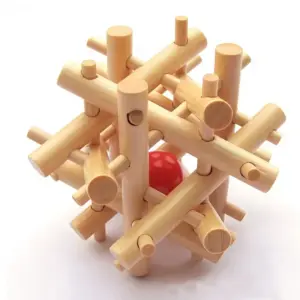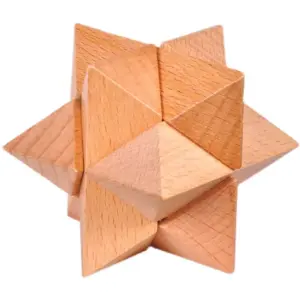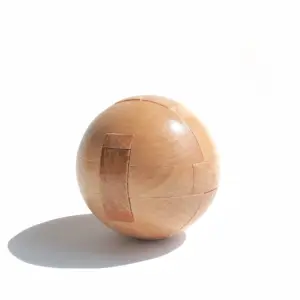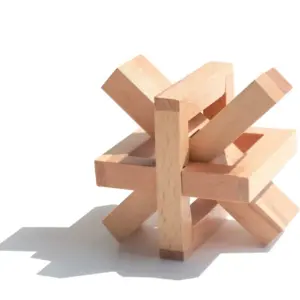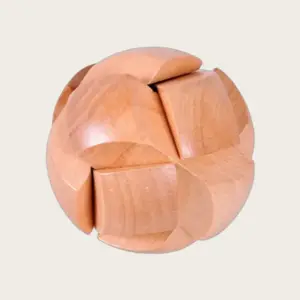I’ve been reviewing puzzles for the better part of a decade, and I’ll be straight with you: the Twelve Sisters Puzzle is one of those rare finds that makes you question everything you thought you knew about spatial reasoning. It sits on my desk right now—twelve thick wooden rods, twelve slender sticks, and one crimson sphere that mocks me every time I glance at it. This isn’t your grandmother’s jigsaw puzzle. This is geometry with attitude.
What Makes the Twelve Sisters Puzzle Different From Every Other Wooden Puzzle
Let’s talk construction first, because that’s where this thing either wins you over or sends you running. Each of the twelve thick rods features precisely drilled holes arranged in what can only be described as deliberately confusing patterns. These aren’t random—they’re geometrically calculated to create an interlocking lattice that, when assembled correctly, forms a self-supporting structure that needs zero glue or fasteners.
The twelve thin sticks? They’re your connectors, threading through those holes to lock everything together. And that red ball everyone keeps mentioning in reviews? It’s not decorative—it’s your checkpoint. When you’ve built the framework correctly, that sphere drops into the center and sits there like a little red trophy saying “you’re halfway there, keep going.”
I’ve handled cheaper versions of geometric puzzles, and the difference is night and day. The wood quality here is legitimate—smooth finish, no splinters, holes drilled clean. You can tell someone actually measured twice and cut once, which matters when you’re dealing with tolerances this tight.
Disassembly: The Easy Part (Don’t Get Cocky)
Taking apart the Twelve Sisters Puzzle is almost insultingly simple. Grab any protruding thin stick, pull gently, and the whole structure starts yielding. Within thirty seconds, you’ve got a pile of wooden pieces and a growing sense of confidence that you’ll definitely remember how this goes back together.
Spoiler alert: you won’t.
This is the trap. The disassembly lulls you into thinking you’ve got this figured out. You see the pieces come apart and your brain goes “oh yeah, that’s just rods and sticks, no problem.” Then you sit down to rebuild it and realize you’ve retained approximately nothing useful from watching it collapse.
Assembly Guide: Where Things Get Real
Phase One: Building Your Foundation Triangle
Here’s where most people hit their first wall. You need to create a stable triangular unit using three thick rods and three thin sticks. Start with Rod A—insert a thin stick horizontally through one of its holes. Cross another thin stick through a different hole to form an X pattern.
Now comes the critical part: Rod B must be parallel to Rod A when you connect it to that first thin stick. I cannot stress this enough—if your rods aren’t parallel, everything downstream falls apart. Thread your third thin stick through Rod B, then bring in Rod C through the intersection point of your crossed sticks. You’re forming a three-dimensional triangle here, not a flat one. That last thin stick connects Rods A and C, locking your foundation.
If you’ve done this correctly, your structure should feel stable when you set it down. If it’s wobbly, something’s misaligned. Don’t proceed until this base is solid—trust me on this.
Phase Two: Expanding and Adding the Sphere
With your triangle stable, start threading three more thin sticks through available holes. The pattern matters here: you’re building outward and upward simultaneously. Install three thick rods next, angling them diagonally from top to bottom. Each rod should mirror its opposite counterpart—parallel lines are your friends throughout this entire build.
Add another set of three thin sticks, following that “each stick connects four rods” principle. This is where the Twelve Sisters Puzzle starts looking less like random sticks and more like an actual structure. When your framework opens up enough, drop that red ball into the center. Feels good, doesn’t it? You’re past the halfway point.
Phase Three: The Final Push (AKA Where You Question Your Life Choices)
Those last three thick rods are legitimately challenging. They need to cross-lock with everything you’ve already built, and the tolerances get tighter as available space shrinks. Each rod must stay parallel to its opposite-side partner—this isn’t optional geometry, it’s mandatory.
That final rod? You’ll probably need to flex the structure slightly to create insertion space. Push the top section up gently, angle the rod’s bottom end into place, then guide it home. It’ll click when it’s right—you’ll feel it. Thread your remaining three thin sticks through their holes, give everything a gentle shake to test stability, and congratulations: you’ve conquered the Twelve Sisters Puzzle.
Video Solution Breakdown: What You’re Actually Seeing
I’ve watched the YouTube assembly video about fifteen times while writing this, and here’s what most people miss: the speed. When you watch someone who knows the pattern fly through assembly, your brain tricks you into thinking it’s easier than it is. Slow that video down to 0.5x speed and really watch the hand positioning—notice how they pause before inserting each rod to check alignment? That’s not showmanship, that’s necessity.
The video demonstrates the parallel-rod principle beautifully around the 0:18 mark. See how the assembler consistently checks opposite sides before locking pieces? That’s your biggest takeaway. The Twelve Sisters Puzzle punishes assumptions and rewards verification.
Common Mistakes (That I Definitely Didn’t Make Multiple Times)
Forcing pieces is mistake number one. If a stick isn’t sliding through cleanly, you’re either using the wrong hole or your rod alignment is off. Back up a step rather than muscling through—you’ll save yourself frustration and potential wood damage.
Ignoring the parallel principle is mistake number two. Every thick rod has an opposite-side partner it needs to mirror. Break that rule and you’ll build yourself into a corner where the final pieces physically won’t fit.
Losing track of which holes you’ve used is mistake number three. Those thick rods have multiple holes, and not all of them get used. I recommend inserting sticks immediately after placing rods rather than placing all rods first—it’s easier to track progress that way.
Is the Twelve Sisters Puzzle Actually Worth Your Time?
Let’s address the elephant in the room: this puzzle takes time. If you’re looking for quick entertainment between meetings, this isn’t it. Your first successful assembly might take anywhere from forty-five minutes to three hours depending on your spatial reasoning skills and patience levels.
But here’s the thing—it’s satisfying in ways that quick puzzles aren’t. There’s genuine accomplishment when those final pieces click into place and you’re holding a self-supporting wooden structure you built from loose components. It’s tactile problem-solving that actually engages your brain instead of just your fingers.
The quality justifies the investment too. This isn’t particle board or cheap pine—you’re getting properly finished hardwood that’ll survive countless assemblies. I’ve taken mine apart and rebuilt it probably twenty times while testing for this review, and the pieces show zero wear.
Who Should Buy the Twelve Sisters Puzzle?
This puzzle shines for specific audiences. If you’re someone who loves Rubik’s cubes, mechanical puzzles, or anything that makes you think spatially, you’ll appreciate what the Twelve Sisters Puzzle offers. It’s also fantastic as a gift for people who claim they’ve “solved everything”—this will humble them real quick.
Parents looking for screen-free activities for teenagers? This works. I’ve seen multiple reviews mentioning how it kept kids engaged for hours, which in 2025 is basically a miracle. Just make sure they’ve got the patience for it—this isn’t a participation-trophy puzzle.
For casual puzzlers or people who get frustrated easily? Maybe skip this one. There’s no shame in knowing your limits, and the Twelve Sisters Puzzle doesn’t offer much middle ground between “solved it” and “threw it across the room.”
The Verdict: Does It Live Up to the Hype?
After spending way too many hours with this thing, here’s my honest take: the Twelve Sisters Puzzle delivers exactly what it promises—a legitimate challenge wrapped in quality craftsmanship. It’s not perfect (I wish it came with a display stand, and those instructions could be clearer), but the core experience is solid.
At its price point, you’re paying for materials and design complexity, not brand name. Compare it to mass-market puzzles at similar prices and the Twelve Sisters Puzzle wins on build quality every time. Will everyone love it? No. Will puzzle enthusiasts find it worth every penny? Absolutely.
If you’re on the fence, ask yourself this: do you want a puzzle you’ll solve once and shelve, or one you’ll challenge yourself to master and maybe even time yourself on repeated assemblies? The Twelve Sisters Puzzle is firmly in that second category. It’s not just about solving it—it’s about understanding the geometric principles well enough that assembly becomes intuitive rather than trial-and-error.
That’s the real genius here. This isn’t a puzzle with one correct solution path you memorize. It’s a system you learn to understand. And once you’ve got that understanding locked in, taking it apart and rebuilding it becomes almost meditative—challenging enough to stay engaging, but familiar enough to be satisfying.
Bottom line? If you’re serious about puzzles and want something that’ll actually test your skills while looking good on your shelf, the Twelve Sisters Puzzle earns its reputation. Just don’t say I didn’t warn you about those final three rods.


